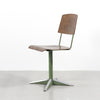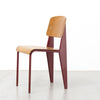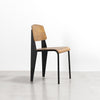Galerie Patrick Seguin
Jean Prouvé
Jean Prouvé, Croismare, Ecole de Verrerie (school of glassmaking), 1948
Jean Prouvé
Designer
Jean Prouvé was born in Nancy, France in 1901, where he died in 1984. He is widely acknowledged as one of the twentieth century's most important and influential designers whose wide-ranging oeuvre combined bold elegance with economy of means and strong social conscience. Working as a craftsman, designer, manufacturer, architect, teacher, and engineer, his career spanned more than sixty years, during which time he produced prefabricated houses, building components and facades, as well as furniture for the home, office and school. Prouvé has played a pivotal role in the development of cutting-edge technology and modular systems for mass production in the post-war modernist period. Prouvé trained as an artisan blacksmith and his intimate knowledge of metal remained the foundation of his work and career. Aware of the limitations of ornamental and wrought-iron work and keen to embrace the modern movement, he moved on to steel and aluminum, folding and arc-welding. In 1931 he established the Atelier Jean Prouvé, where he began to produce light-weight metal furniture of his own design, as well as collaborating with some of the best-known designers of his time, including Le Corbusier and Charlotte Perriand. Furniture production became a core part of his business. He favored the public sector in the growing areas of health, education and administration, which reflected a social ideal but also offered the economies of scale. By 1936 he was producing a catalogue of standard models for hospitals, schools and offices. The potential for mass production inspired Prouvé to develop and patent industrial products using folded sheet metal for the construction of buildings. These included movable partitioning, metal doors and elevator cages. The onset of WWII and the age of austerity that followed marked a period of enforced experiment for Prouvé and in 1947 he moved his operations to Maxéville, just outside Nancy. With his own design studio, he could combine research, prototype development and production. At Maxéville he set about fulfilling his ambitious plan to alter the building process from a craft-based practice to that of a mechanized industry, producing not only houses, prefabricated huts, doors, windows, roof elements and façade panels but also a production line for furniture based on his own designs. It was in this creative environment that the prefabricated refugee houses of 1945 were developed, followed by the flat-packed, tropical houses for Niger and the Republic of Congo in 1949 and 1950. His work is included in private and public collections worldwide, including Centre Georges Pompidou, Paris and Museum of Modern Art, New York. Major exhibitions include “Jean Prouvé: Constructeur, 1901–1984,” Centre Georges Pompidou, Paris (1990–91); “Jean Prouvé: Three Nomadic Structures,” Pacific Design Center, Museum of Contemporary Art, Los Angeles (2005); “Jean Prouvé: A Tropical House,” Hammer Museum, Los Angeles (2006); “Jean Prouvé: The Poetics of the Technical Object,” Vitra Design Museum, Weil am Rhein, Germany (2006–07, traveled to Kamakura Museum of Modern Art; Deutsches Architekturmuseum, Frankfurt; Netherlands Architecture Institute, Maastricht; Hotel de Ville de Boulogne-Billancourt, Paris; Design Museum, London; and Museo dell'Ara Pacis, Rome, among other venues); “Ateliers Jean Prouvé,” Museum of Modern Art, New York (2008-09); a multi-exhibition, multi-venue tribute at Musée des beaux-arts, Nancy, France (2012); and “A Passion for Jean Prouvé: From Furniture to Architecture,” Pinacoteca Agnelli, Turin (2013).
Exhibited at Design Miami/ Basel 2022 Created at the instigation of the glassmaker Paul Daum by the Glassworks Union to ensure the future of this industry by training a quality workforce, the Croismare apprenticeship centre was designed to accommodate young people in boarding schools who were following a practical course at the former Muller factory, located nearby.
In 1937, encouraged by new measures taken by the French Government in favor of holidays for the working classes, JEAN PROUVÉ boldly launched himself into the market of small, prefabricated leisure constructions, lightweight and movable. Thus ensued numerous architectural projects such as the BCC demountable house (1941), the 6x6, 6x9 and 8x8 demountable houses (1944), the Croismare training centre (1948), the Bouqueval school (1950), and the Better Days house (1956).
Thanks to their adaptability and their creator’s powers of anticipation, Jean Prouvé’s buildings and architectural elements, which were mostly designed to be temporary, mobile or modular, are just as relevant today as models of sustainable building.
The creation of the Croismare training centre, whose school is partially reconstructed for DesignMiami/ Basel, was instigated by glassmaker Paul Daum and carried out by the Glassmakers’ Union in order to ensure the future of the industry by training a quality workforce.
This building is the most imposing central portal frame realisation ever produced by the Ateliers Jean Prouvé.
The 255m2 (2745 sq. ft.) building numbers seven central portal frames, over 3 meters high, and two external walkways that derive their elegance from the slenderness of the tubular portal frames. The facade panels, solid or glazed, give rhythm and contrast. The monumental entrance canopy in folded sheet steel is an autonomous module supported by two struts, key elements in Prouvé’s work.
The Croismare school is one of the finest examples of Jean Prouvé’s constructive thinking and unites in a single project
all the fundamental principles of his buildings.
32×8m / 105×26’3 ft





